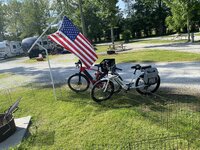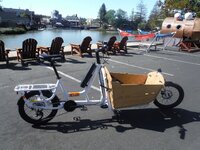I've test ridden a lot of different e-bikes over the last couple months trying to find what fits me best. This would be a second bike for me, I currently own a hub motor bike from Juiced Bikes. I've tried hub drives and mid drives from a lot of the big brands (Juiced, Rad, Specialized, Reise & Mueller, Gazelle, EVELO) and it seems like no matter what the hub drive bikes are always zippier than the mid drive bikes.
What do I mean by this? Basically it seems like the hub drives always accelerate faster and the motor responds quicker when you put more pressure on the pedals or press the throttle. By contrast the mid drives have slower acceleration and take more pedal pressure before I feel increased motor output.
I posted all of the above on another ebike forum and a common reply I got was that I was probably feeling the difference between cadence sensor pedal assist vs torque sensor pedal assist, but this doesn't seem to line up with my experience. For example, my Juiced bike (Ocean Current model) is a hub drive with torque and cadence sensor and the ride feels very similar to a friends Rad bike (Rad Expand 5 model) which is hub drive and cadence sensor only. They both have that zippy feeling I like. In contrast I have recently been riding an EVELO (Omega model) which is mid drive with torque and cadence sensor and it feels quite a bit different than the other two bikes. So at least in my limited experience it seems like the motor type makes a bigger difference than the pedal assist sensor type for how the ride feels.
I am wondering if other people who have ridden both types of motor feel the same way or have I just not ridden the right type of mid drives? Does anyone know of any mid drive bikes that feel really zippy like my hub drive bike? (Preferably a commuter style)
What do I mean by this? Basically it seems like the hub drives always accelerate faster and the motor responds quicker when you put more pressure on the pedals or press the throttle. By contrast the mid drives have slower acceleration and take more pedal pressure before I feel increased motor output.
I posted all of the above on another ebike forum and a common reply I got was that I was probably feeling the difference between cadence sensor pedal assist vs torque sensor pedal assist, but this doesn't seem to line up with my experience. For example, my Juiced bike (Ocean Current model) is a hub drive with torque and cadence sensor and the ride feels very similar to a friends Rad bike (Rad Expand 5 model) which is hub drive and cadence sensor only. They both have that zippy feeling I like. In contrast I have recently been riding an EVELO (Omega model) which is mid drive with torque and cadence sensor and it feels quite a bit different than the other two bikes. So at least in my limited experience it seems like the motor type makes a bigger difference than the pedal assist sensor type for how the ride feels.
I am wondering if other people who have ridden both types of motor feel the same way or have I just not ridden the right type of mid drives? Does anyone know of any mid drive bikes that feel really zippy like my hub drive bike? (Preferably a commuter style)

